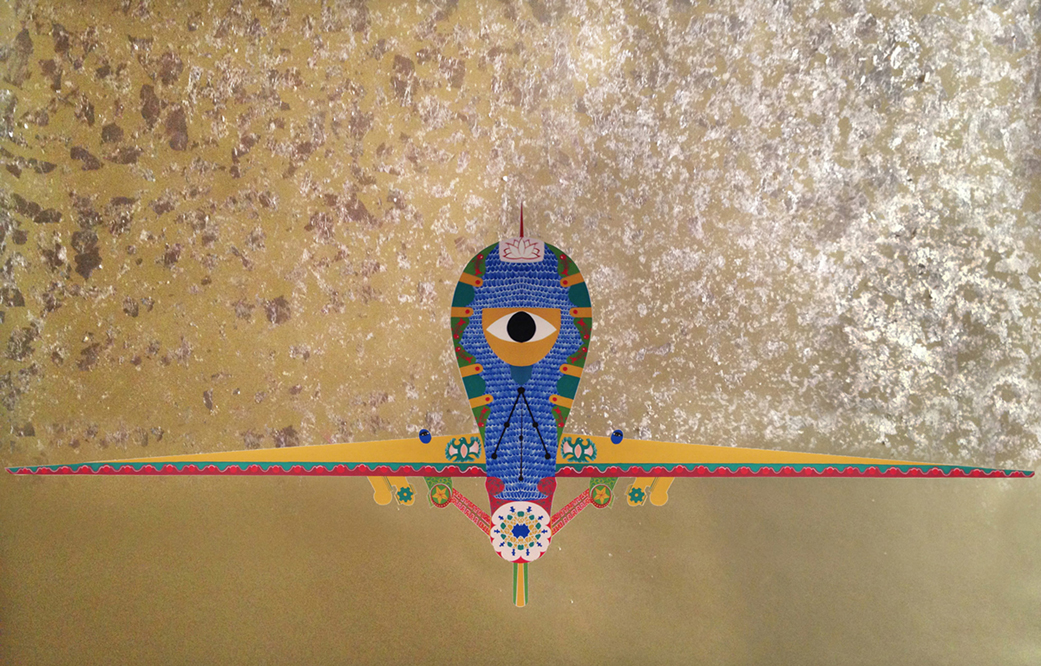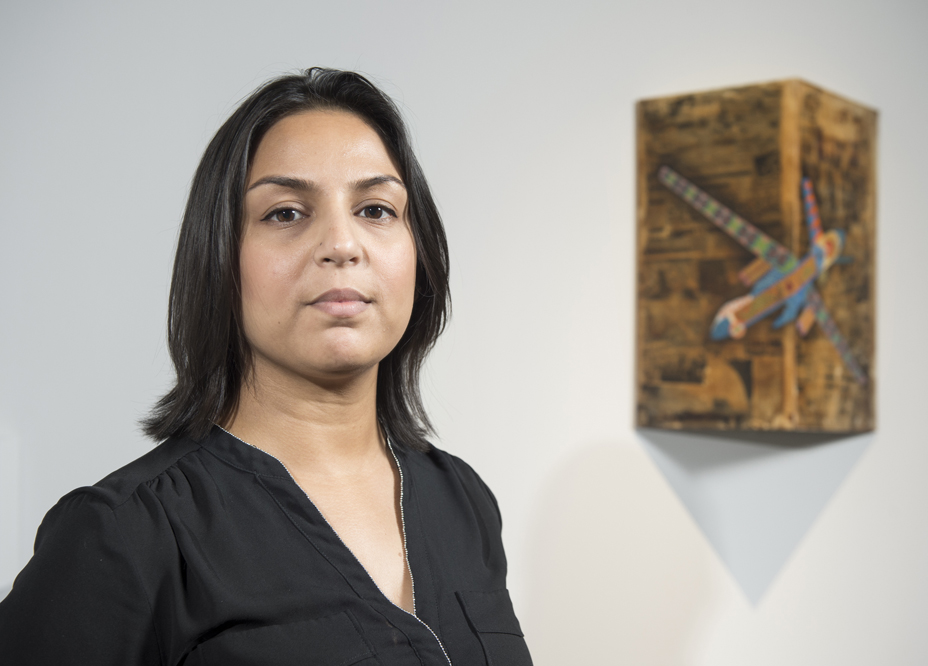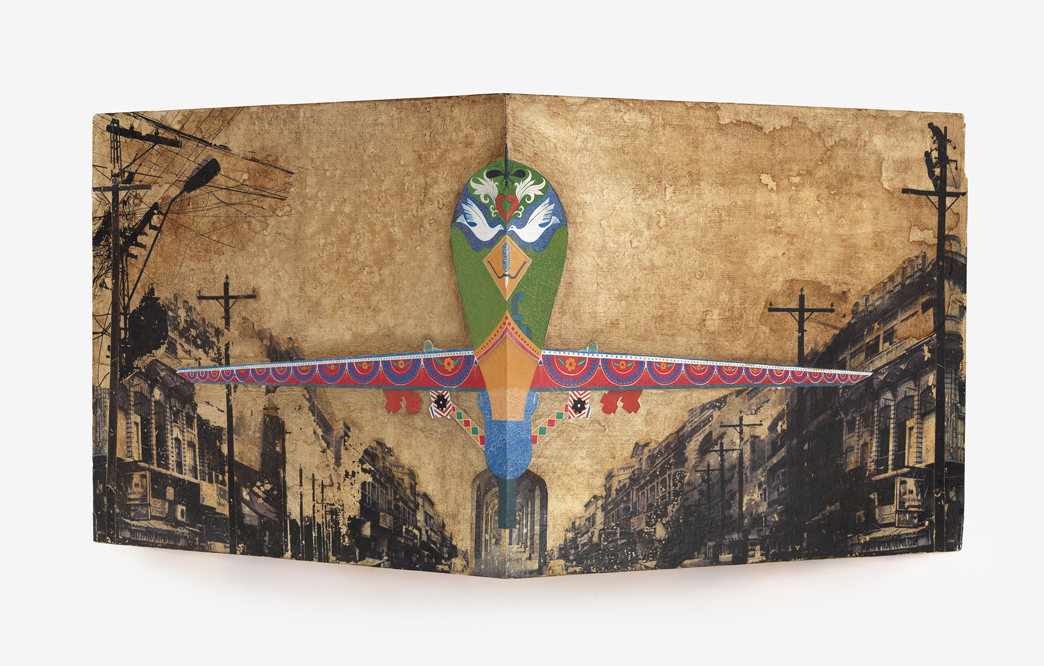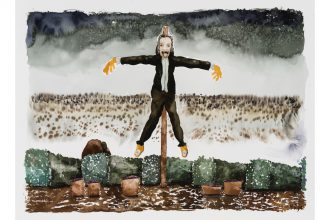What’s at stake – aesthetically and politically – when we imagine the drone as an emblem for contemporary society? Consider the range of artistic work on the now-ubiquitous devices: how they function as “seeing machines” (Trevor Paglen); how we can best render ourselves undetectable to their gaze (Hito Steyerl); how we can make drones visible (James Bridle); how drones produce images (Harun Farocki); how those images contribute to a culture of anxious surveillance (Laura Poitras, among others). Creative discourse hasn’t exhausted the subject matter, as artists explore its depths. Drone art encompasses a swath of practices ranging from craft and textile to new-media installation. Many of these approaches address drones relationally: who and what they impact, how they “see” us, what kinds of environments they create. Such practices offer a way of conceptualizing drones as catalysts of a certain political climate.
Mahwish Chishty’s paintings and models, currently on display at London’s Imperial War Museum, take a different tack. Her work considers these weapons primarily as material objects within the specific geopolitical setting of US/Pakistan relations after 9/11. Trained as a miniature painter at Lahore’s National College of Arts, Chishty explores – as per her artist’s statement – “the juxtaposition of terror with the representation of cultural beauty.” This tension arises from her appropriation of Pakistani “truck art” – a form of decorative folk painting on the exterior of haulage trucks in Pakistan’s north-west region – onto the bodies of drones, often incorporating Urdu text and symbolic imagery. Decorative truck art weaves poetry, myth, and folklore to produce its own political meaning which, by virtue of the vehicles’ mobility, shapes the landscape of Pakistan. When grafted onto the skins of drones in Chishty’s paintings, however, the trappings of this traditional form are compressed, suggesting to unacquainted audiences an exoticism rather than cultural complexity. This flattening is reflected in the paintings themselves; the outlines of drones are silhouettes of images that Chishty has taken from the internet, later filling them in with painstaking detail and transposing them onto brown backgrounds.
Gouache paintings titled after particular models like MQ 9-2 (2011) combine the hyper-detail of miniaturist painting with the symbolic imagery associated with US drone strikes. Skull-and-crossbones occupy the same visual space as vegetal patterns rendered in blue, orange, red, and green; the non-figurative stipulations of Islamic visual art are a clear influence on Chishty, but not a strict boundary. Natural allegory abounds in paintings like Reaper (2015). Tiny blue birds and wide-open eyes make broad gestures, as flakes of gold-leaf shimmer against visibly warped, tea-stained paper. In works like this, the colorful decorative designs and gold foil situate the vehicles in neither sky nor ground, transmuting aerial logic to one that floats outside spatial bounds. The top-down omniscience of the perspective allows the viewer to see the drone as it sees its anonymized targets: distantly, and within a landscape of decontextualized cultural specificity.
Elsewhere, Chishty’s emphasis on materiality places drone warfare in real, rather than fictive, landscapes. Three-dimensional paintings such as By the Moonlight (2013), rendered on plywood jutting out against the gallery walls, offer a perspectival shift from the rest of her works. Echoing the gouache works, the plywood is also stained brown with tea, bringing into precise relief the linear patterns of the wood grain. Here the drab stain is accompanied by a photographic transfer of an urban Pakistani street, viewed from a classic one-point perspective. In framing this familiar scene against the backdrop of her paintings of war-machines, Mahwish Chishty makes a case for cultural specificity, bringing viewers to the exact place where violence occurs: a counterpoint to the dystopian abstractions nervously imagined by Paglen and Poitras.
This specificity is also embedded in the loaded symbolism and microscopic detail of Chishty’s paintings. The artist encourages the viewer to look more closely at a form of violence that continually makes itself impossible to see. She is not alone in this tradition – consider the collective project #notabugsplat, which renders visible the deaths (via predator drones) of Pakistani citizens in North Waziristan by enlarging photographs of the victims’ faces so that they can be seen from an aerial perspective. Her technique is also similar to her compatriot Imran Qureshi, who also trained as a miniature painter, and whose installation for the Met Roof Garden incorporated a similar visual tactic as the #notabugsplat group. In both cases, contrary to Chishty’s focus on the materiality of drones, these projects focus on the impact of drone violence. Coverage of drone warfare still demands humanized narratives to justify its actions: one needs only to consider the now canonical testimony of Zubair Rehman, who in 2013 testified in a congressional hearing on civilian drone strikes: “I now no longer love blue skies. In fact, I now prefer grey skies. The drones do not fly when the skies are grey.”
Stare at something long enough, and it begins to look alien. In an effort to defamiliarize the weapons, Chishty’s use of bright color and detail foregrounds surfaces rather than the drone’s better-publicized material impacts. By focusing on the surface decoration of the UAVs (unmanned airborne vehicles), Chishty attempts to denaturalize a tool of warfare that has largely been normalized by a global community. Such a skin-deep emphasis, however, reduces the complexity of this violence to a matter of visibility, relying on representation to intimate a set of problems that goes far beyond ways of seeing.
The stealth nature of drone warfare is only one of its tendentious qualities. The ripple effects of remote violence create an environment of paranoia, restricting mobility and propagating fear. Presented in glass vitrines alongside the paintings are models of Chishty’s subjects: Reaper (2016), Stealth (2015), and Predator (2015). Painted in the primary colors of children’s toys, some with the same minute truck art details of her paintings, the models darkly underscore the difficulty of representing the psychological and social impacts of virtualized war. But do colorful models of drones make their association more or less potent? Put differently, would it matter if these drones were fully-operational weapons, instead of scale models?
Effectively, Chishty juxtaposes the inherent danger of drones-as-weapons with the non-danger of drones-as-toys. Doing so, however, raises broader, thornier questions about the value of applying generalized, aesthetic responses to highly-specific political questions. Instead of answering this question, Chishty asks a more pragmatic one: should artists focus on cultural specificity or try and appeal to universal ethics? Her answer is simply this: drones are a part of everyday life in Pakistan, and there is no need for to justify this work otherwise. Regarding the inclusion of IMW Contemporary: Mahwish Chishty at Britain’s Imperial War Museum, curator Alex Walton notes that: “Chishty’s exhibition is new in that this is the first time the museum has shown work by a non-British artist who has direct links with the region where this type of war is fought. Drone warfare in Pakistan is part of the context of the wars in Iraq and Afghanistan, and reflects the current state of globalized conflict.”
The latter part of Walton’s statement is a one of fact, but its truth is not particularly reflected in Chishty’s work. Her emphasis on surface suggests that drones are only dangerous because they’re used as weapons. Of more pressing concern is the ambiguous ethics of warfare that reduces victim and perpetrator to anonymity. The artist succeeds in contextualizing a type of global violence within a specific cultural locale. She is able to circumvent the thorny ethics of “aestheticizing” war by taking “war” as an abstraction: the paintings of drones are used metonymically, but they never truly relate to a larger global phenomenon. Within the smaller world of London’s IMW, Chishty presents drones as always situated elsewhere, never implicating the viewer in responsibility, nor acknowledging the wider scope of the kind of violence that drones produce. This is less a criticism of Chishty than it is of physics: to move closer to one thing, you must move further away from something else.





























